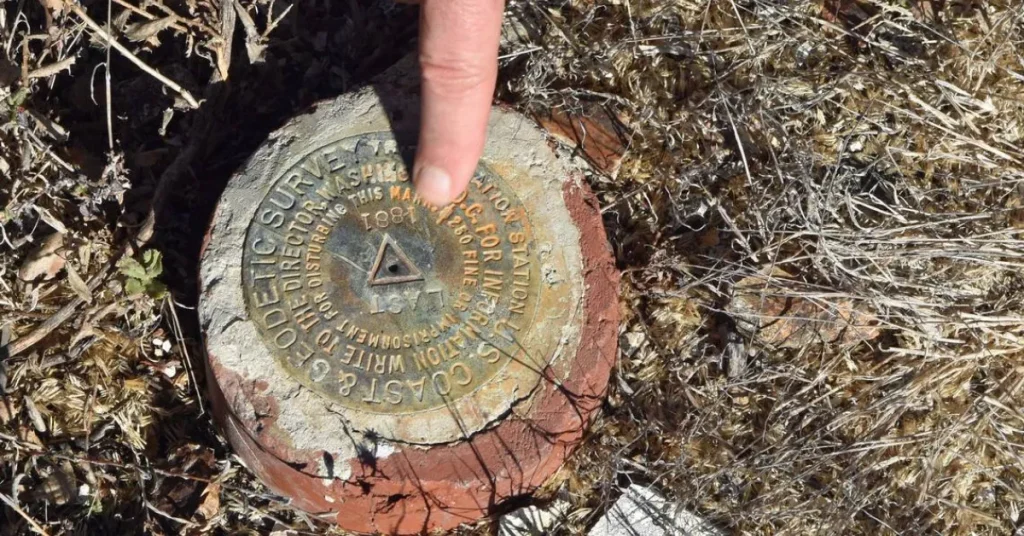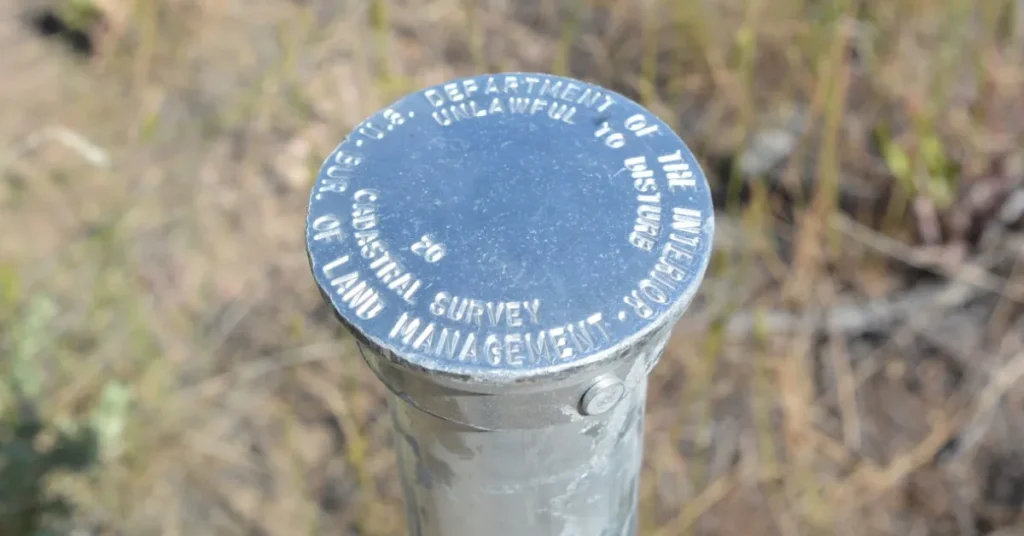Survey pins are typically buried about 6 to 10 inches below the surface. This depth can vary depending on the local regulations and soil conditions.
Establishing property boundaries is crucial for homeowners, real estate developers, and architects.
Survey pins, small metal rods or pipes, play a significant role in marking the precise corners of a parcel of land. By accurately determining these points, disputes can be minimized, and land development plans can be executed with confidence.
Knowing the depth of these pins is essential for those needing to locate their property lines for construction, fencing, or landscaping purposes.
As markers of legal boundaries, they must be both visible to surveyors and secure from shifting due to weather or incidental contact.
This introduction to survey pins provides not only technical information about their placement but also insight into their importance in land ownership and development.

Introduction To Survey Pins
Survey pins are critical markers used in the world of land surveying. These small but vital components play a huge role in determining property boundaries.
They are often made from durable materials to withstand different weather conditions and are buried deep in the ground to provide a permanent reference point for measuring land.
The Role Of Survey Pins In Land Measurement
Survey pins serve as the “cornerstones” of land ownership. They mark the exact corners where property lines begin and end.
This precision ensures that land measurements are accurate and reliable. Without survey pins, properties could not be defined, leading to potential disputes and legal issues.
- Marks property corners
- Aids in constructing fences and buildings
- Helps avoid land disputes
Types Of Survey Pins Used
Survey pins come in various types, each serving specific functions. Common materials include reinforced steel and iron rods, though more modern alternatives like plastic capped stakes are also in use.
| Survey Pin Type | Material | Common Uses |
| Iron Rods | Iron | General property surveys |
| Wooden Stakes | Wood | Temporary markers during construction |
| Plastic Capped Stakes | Plastic and metal | Visible property marking |
Survey Pin Depth Basics

Survey pins are vital in property boundary definition. They are metal rods placed by surveyors. Their depth is important. It must be enough to prevent movement. Also, it should not be too deep.
This makes them hard to locate. Let’s delve into what sets the standard depths and what factors influence how deep these pins are buried.
Standard Depths For Survey Pins
Typically, survey pins are buried between 18 to 30 inches underground. This depth ensures stability.
It also keeps the pins safe from surface activities. Weather conditions can affect this depth. Here is a quick look at usual depths based on pin types:
| Type of Pin | Typical Depth |
| Iron Rod | 24 to 30 inches |
| Wooden Stake | 18 to 24 inches |
| Rebar | 24 to 36 inches |
Factors Affecting Survey Pin Depth
Several factors can change the depth of survey pins. Each factor is critical. They ensure the pin stays fixed over time. Factors include:
- Soil type: Sandy or loamy soils may require deeper pins.
- Frost line: In colder regions, pins are placed below it to avoid heaving.
- Construction: Near construction sites, pins must be deeper for safety.
Installation And Detection
Understanding how survey pins are installed and detected is crucial for anyone working with land boundaries. Survey pins play a pivotal role in marking property lines accurately. They need precise installation and the right techniques for location.
Methods For Installing Survey Pins
Effective installation ensures durability and accuracy for survey pins. The depth can vary depending on regulations and requirements. Typically, professionals bury them several feet underground to prevent shifting and preserve property lines.
- Manual Hammering: Workers use sledgehammers to drive the pin into the ground.
- Drilling: For harder soils, a drill creates a hole for the pin.
- Post-Driver Machines: These machines offer precise and faster installations.
Techniques To Locate Buried Survey Pins
Detection of buried survey pins requires skill and the right tools. With these techniques, one can find buried pins with ease.
| Technique | Description |
| Metal Detectors | Useful for detecting metal pins underground. |
| Magnetic Locators | Employ magnets to locate iron or steel pins. |
| Ground-penetrating Radar (GPR) | Uses radar pulses to image the subsurface. |
| Probing Rods | Slim, metal rods pushed into the ground to feel the pin. |
Legal Implications
Legal Implications of buried survey pins run deep, much like the pins themselves. Homeowners and land developers often overlook these implications. Correct knowledge and handling of survey pin regulations can save one from potential legal battles.
Survey Pin Regulations
Knowing the laws around survey pin placement proves crucial. Violations could lead to serious penalties. Guidelines often state:
- How deep survey pins must be buried.
- The type of material used in the pins.
- Visible markers should accompany the buried pins.
This ensures survey pins remain secure and locatable. Survey laws differ across regions, making it vital for property owners to check local codes.
Resolving Disputes Over Property Lines
Disputes over property boundaries can escalate quickly. In such cases, refer to the legally placed survey pins. Property owners should:
- Obtain a new property survey from a licensed surveyor if pins are lost or buried too deep.
- Consult local land records for historical surveys.
- Seek mediation if there’s a conflict with neighbors.
This approach often resolves the matter without resorting to legal action. Always prioritize communication and documentation in these scenarios.
Maintaining And Replacing Survey Pins

Survey pins mark the boundaries of a property. Ensuring these markers remain visible and in place is critical for property owners. Over time, survey pins can become buried or damaged. Regular maintenance and prompt replacement of these pins is a must.
When To Check Survey Pin Integrity
Property owners should assess the condition of survey pins annually. This helps prevent disputes with neighbors. Check after significant weather events too. Signs of corrosion, shifting, or damage mean it’s time for action.
Steps For Replacing Lost Or Damaged Pins
- Locate the original survey report; it’s essential for accuracy.
- Contact a licensed surveyor if you can’t find or see the pin.
- The surveyor will find or place new pins precisely.
- Document the replacement for your records and future reference.
| Task | Details |
| Identify | Find the missing or damaged pin |
| Measure | Measure exact location from report |
| Replace | Surveyor installs a new pin |
| Record | Make note of the change |
Replacing survey pins is straightforward but requires precision. Trust professionals to ensure your property lines remain accurate and respected.
FAQs About How Deep Are Survey Pins Buried
How Deep Should Survey Pins Be Placed?
Survey pins are typically buried at a depth of 18 to 30 inches. The depth ensures that they are below the frost line to avoid shifting and remain stable.
Are Survey Pins Visible Above Ground?
Survey pins are usually flush with the ground or just below the surface. In some cases, they might be capped with a plastic or metal cover that is slightly visible.
What Tools Are Used To Locate Survey Pins?
Metal detectors and magnetic locators are commonly used tools to find buried survey pins. Surveyors might also use specialized equipment if the pins are deeper or harder to locate.
How Long Do Survey Pins Last Underground?
Survey pins made of durable materials like stainless steel or iron can last for several decades underground. Their longevity can be affected by soil conditions and corrosion.
Conclusion
Understanding the depths at which survey pins are buried is crucial for accurate land demarcation. Usually, these markers rest at a depth that protects against common disturbances while remaining accessible for surveyors.
Remember, local regulations may dictate the specific depth, so checking with regional guidelines is always advised.
Ensuring pins are properly placed preserves boundary integrity for years to come.
Resources:
1. https://claycountymn.gov/1231/Property-Lines
